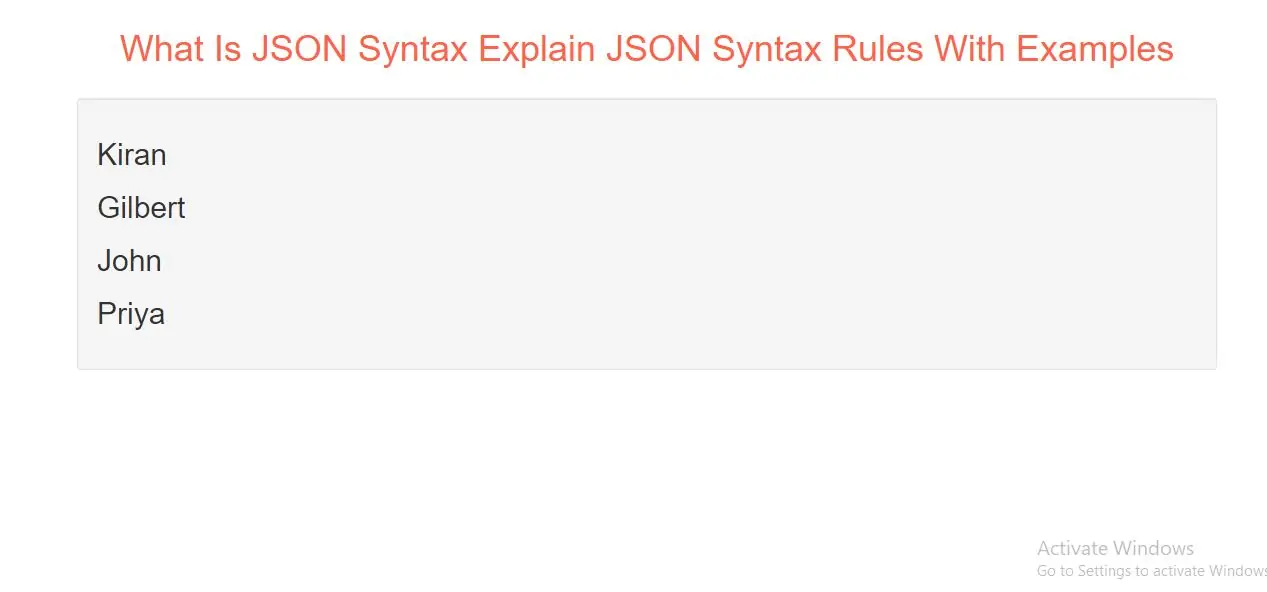
JSON Syntax Rules
JSON syntax is derived from JavaScript object notation syntax:
Data is in name/value pairs
Data is separated by commas
Curly braces hold objects
Square brackets hold arrays
JSON Data - A Name and a Value
JSON data is written as name/value pairs.
A name/value pair consists of a field name (in double quotes), followed by a colon, followed by a value:
Company_name: "Bajarangisoft"
JSON names require double quotes. JavaScript names don't.
JSON - Evaluates to JavaScript Objects
The JSON format is almost identical to JavaScript objects.
In JSON, keys must be strings, written with double quotes:
JSON
{ Company_name: "Bajarangisoft"}
In JavaScript, keys can be strings, numbers, or identifier names:
JavaScript
{ Company_name: "Bajarangisoft"}
JSON Values
In JSON, values must be one of the following data types:
In JavaScript values can be all of the above, plus any other valid JavaScript expression, including:
In JSON, string values must be written with double quotes:
JSON
{ "Company_name":"Bajarangisoft" }
In JavaScript, you can write string values with double or single quotes:
{ "Company_name":"Bajarangisoft" }
JSON Uses JavaScript Syntax
Because JSON syntax is derived from JavaScript object notation, very little extra software is needed to work with JSON within JavaScript.
With JavaScript you can create an object and assign data to it, like this:
var company = { Company_name: "Bajarangisoft", since: 2, city: "Banglore" };
You can access a JavaScript object like this:
Example(1)
// returns John person.name;
// returns John person["name"];
person.name = "Gilbert";
It can also be modified like this:
person["name"] = "Gilbert";
JavaScript Arrays as JSON
The same way JavaScript objects can be used as JSON, JavaScript arrays can also be used as JSON.
JSON Files
The file type for JSON files is ".json"
The MIME type for JSON text is "application/json"
Complete Code For JSON Syntax.
<!DOCTYPE html>
<html>
<head>
<title>What Is JSON Syntax Explain JSON Syntax Rules With Examples</title>
<meta charset="utf-8">
<meta name="viewport" content="width=device-width, initial-scale=1">
<link rel="stylesheet" href="https://maxcdn.bootstrapcdn.com/bootstrap/3.4.1/css/bootstrap.min.css">
</head>
<body>
<div class="container">
<br>
<div class="text-center">
<h1 id="color" style="color: tomato">What Is JSON Syntax Explain JSON Syntax Rules With Examples</h1>
</div>
<br>
<div class="well">
<h2 id="demo1"></h2>
<h2 id="demo2"></h2>
<h2 id="demo3"></h2>
<h2 id="demo4"></h2>
<h2 id="demo5"></h2>
</div>
<script>
//example1
var myObj, x;
myObj = {name: "Kiran", age: 30, city: "New York"};
x = myObj.name;
document.getElementById("demo1").innerHTML = x;
//example2
var myObj1, x1;
myObj1 = {name: "Shiva", age: 20, city: "Delhi"};
myObj1["name"] = "Gilbert";
document.getElementById("demo2").innerHTML = myObj1.name;
//example 3
var myObj2, x;
myObj2 = {name: "John", age: 30, city: "New York"};
x = myObj2.name;
document.getElementById("demo3").innerHTML = x;
//example4
myObj3 = {name: "Priya", age: 30, city: "New York"};
x = myObj3["name"];
document.getElementById("demo4").innerHTML = x;
</script>
</div>
</body>
</html>